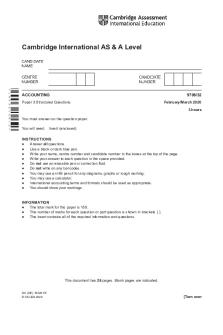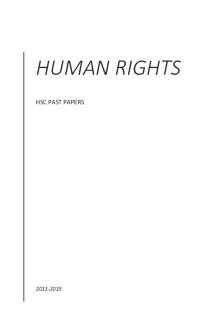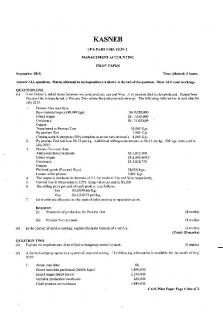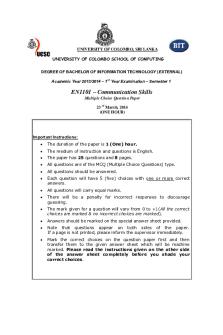AC100-6 - Past exam papers for the course PDF

| Title | AC100-6 - Past exam papers for the course |
|---|---|
| Course | Elements of Accounting and Finance |
| Institution | The London School of Economics and Political Science |
| Pages | 18 |
| File Size | 425.2 KB |
| File Type | |
| Total Downloads | 27 |
| Total Views | 157 |
Summary
Past exam papers for the course...
Description
Suitable for 2012/2013 candidates
Time allowed: 3 hours + 15 minutes reading time You are allowed 15 minutes for reading the question paper. During this time you may write anything in your answer book but you may annotate the question paper if you wish. You are then allowed 3 hours in which to answer the paper. Show all workings clearly, and state clearly any assumptions you need to make. If accounting paper or graph paper is used for any answer, fasten the sheets securely inside the answer book with the string provided. Answer the following questions: Section A: Section B: Section C:
answer any of the twelve questions in this section answer the question in this section answer any of the four questions in this section
Marks are allocated as follows: Section A: 5 marks for each question Section B: Section C: 20 marks for each question TOTAL: You are supplied with:
30 marks 30 marks 40 marks 100 marks
Graph paper Accounting paper Present Value Tables attached to this examination paper
You may also use: Electronic calculator (as prescribed in the examination regulations) except during the period allowed for reading the question paper. All workings should be to the nearest £ unless otherwise stated.
LSE 2013/AC100
Page 1 of 18
Explain the meaning of each of the following: (i) (ii) (iii) (iv)
capital allowance consolidated financial statements intangible assets liabilities
The opening statement of financial position for jewellery retailer, Larry & Co, at 1 January is as follows: £ Assets Cash
Equity Opening equity
100,000 100,000
100,000 100,000
On 1 January Larry purchased gold jewellery for £60,000 and silver jewellery for £40,000. The Retail Price Index (RPI) at that date was 110. All the jewellery was sold on 31 January for £140,000. The RPI at 31 January was 112.2. At the end of January the cost of replacing the gold jewellery had risen by 4% and the cost of replacing the silver jewellery had risen by 1%.
(a) Prepare Larry & Co’s income statement for the month of January using: (i) current cost accounting (ii) current purchasing power accounting.
(b) Briefly describe the objective of each method and comment on the advantages and disadvantages of each method.
LSE 2013/AC100
Page 2 of 18
The following information is available for Maura Ltd: Extracts from the Statements of Financial Position as at 31 December
Non-current Assets Buildings Motor Vehicles
2011 £000
2012 £000
350 95 445
625 120 745
Extract from the Income Statement for the year ended 31 December 2012 Depreciation expense Buildings Motor vehicles Profit on disposal of motor vehicle
£000 30 12 10
During the year to 31 December 2012 Maura sold a motor vehicle, the written down value of which was £15,000. There were no other disposals.
Prepare the cash flow from ended 31 December 2012.
LSE 2013/AC100
activities for Maura Ltd for the year
Page 3 of 18
On 1 April 2010 Universe plc acquired 80% of the ordinary share capital of Planet Ltd for a consideration of £126,000. The equity section of Planet Ltd’s statement of financial position at that date is shown below: Share capital Share premium Retained profits
£ 60,000 22,000 48,000
Included in Planet’s statement of financial position at the date of acquisition was land at cost of £46,000. Land is not depreciable. The value of this land at 1 April 2010 was estimated to be £50,000. The retained profits of Planet Ltd at 31 December 2012 were £62,000. On 31 December 2012 the directors estimated that goodwill had not been impaired since the acquisition.
Calculate Goodwill and Non-controlling interest to be included in the consolidated statement of financial position of Universe plc at 31 December 2012.
Jack and Rose set up an entertainment company together, Jolly Two, on 1 January 2012. Jack contributed £40,000 in capital and Rose contributed £30,000. Under the partnership agreement their annual salaries are as follows: Jack: £15,000 and Rose £12,000. Interest is credited to the partners at 5% per annum on the opening balances of their capital accounts. The residual profits are shared in the ratio Jack 3 and Rose 2. During 2012 Jack withdrew £6,000 and Rose’s drawings were £5,000. Profit for the year ended 31 December 2012 was £62,000.
(a) Prepare the appropriation of profit for the year to 31 December 2012.
(b) Show the partners’ accounts in the balance sheet of Jolly Two at 31 December 2012.
(c) Briefly explain the difference between a partnership and a limited liability company.
LSE 2013/AC100
Page 4 of 18
Answer (a) Identify and explain accounting conventions that limit the scope of financial statements in providing relevant information. (b) When reviewing the draft accounts of a company the auditors find that damaged stock has not been written down for a loss of £100,000. The director says: “We do not need to change the accounts for a loss of £100,000 on damaged stock when our operating profit is £50 million”. Use three qualitative characteristics of financial statements to discuss whether you agree or disagree with the director’s statement.
The packaging department in the Best of Lowlands (BOL) tea factory receives loose tea from the production department. The tea is filled into printed cellophane bags which are then sealed and transferred out to the shipping department. During April 2013, the packaging department transferred 27,000 bags to the shipping department. BOL operates a weighted average process costing system. The following information is available for the packaging department for April 2013:
Equivalent units Work in progress (beginning of April) Work done in April
Costs Equivalent [£] units
Costs Equivalent [£] units
Costs [£]
3,000
7,500
2,250
4,500
-
-
27,000
81,000
25,500
79,050
27,000
54,000
(a) Calculate the total cost of bags completed and transferred out and for work in progress at the end of April 2013. Clearly show your workings.
(b) State the number of physical units in opening and in closing work in progress (WIP). Also state the degree of completion for direct materials cost in opening and closing WIP.
LSE 2013/AC100
Page 5 of 18
Voice Ltd produces sound equipment for conference and teaching venues. Recently, it has received a request to install a new sound system in the Peacock Theatre. The job will have the following material requirements: Component A: Component B: Component C:
30 units 10 units 20 units
Additional information: 1. Component A is normally held in inventories as it is widely used throughout the business’s product range. There are 15 components currently held. These had cost £1,800 each. The sole supplier of this component has announced an immediate price rise of 5% for further purchases. 2. Component B is no longer used for any other of the business’s products. At present there are six components in inventories costing £2,000 each. It is possible to buy additional components at a cost of £2,200 each; however, the supplier insists on a minimum order quantity of six components. Any unused components will be disposed of at a total cost to the business of £250, irrespective of the quantity to be disposed of. 3. Component C is used by the business throughout its product range. At present there is none in inventories. However, an order for 20 components for use in another contract is about to be placed. The supplier normally charges £1,600 per component but for orders above 30 components a discount of 10% is available on the total order price.
(a) What is the relevant cost of the material for the installation of the new sound system in the Peacock Theatre? Clearly explain the treatment of all of the information given in the question.
(b) Explain the concept of opportunity cost in a managerial context.
LSE 2013/AC100
Page 6 of 18
The bakery division of Farm Foods Co. uses the same production facilities to make three different types of bread (white bread, rye bread, and olive bread). The bread is produced in batches which are sold to local supermarkets. The details are as follows:
Selling price per batch [£] Variable cost per batch [£] Daily demand [batches] Machine time per batch [hours]
5.00 2.00 25 0.500
4.00 1.60 20 0.375
4.60 2.40 30 0.500
The production operates 24 hours per day without interruption.
(a) Determine the optimal quantity of each type of bread that the bakery division should produce each day if the business is to make the highest contribution per machine hour to profit. Clearly show your workings.
(b) ‘There is no such thing as a fixed cost because all costs are variable in the long run.’ Do you agree? Explain your answer.
LSE 2013/AC100
Page 7 of 18
A furniture factory has recently expanded its product portfolio to include the production of leather sofas. Material costs per sofa are budgeted at £210, direct labour costs at £450. The budgeted production for the first month was 40 sofas and one sofa was expected to take 15 hours of direct labour. Actual figures for the first month are as follows: Sofas completed: Labour hours worked: Total direct labour costs: Total material costs:
24 560 £16,200 £7,200
(a) Calculate the relevant variances. Show all workings.
(b) Suggest possible reasons for the relevant price and efficiency variances identified in part (a) of this question.
‘The preparation of a company’s published financial reports is entirely disconnected from the preparation of internal management reports.’
Critically discuss this statement.
What is meant by the “Great Moderation” period and in what way is it relevant to understand the 2007 financial crisis?
LSE 2013/AC100
Page 8 of 18
Happy Child plc is a producer of baby toys and accessories. The following trial balance was extracted from its accounting records as at 31 December 2012: Trial Balance at 31 December 2012
Land at cost Fixtures and fittings at cost Plant and machinery at cost Vehicles at cost Provision for depreciation at 1 January 2012 Fixtures and fittings Plant and machinery Vehicles Inventory at 1 January 2012 General expenses Prepayments at 1 January 2012 Interest paid Lighting and heating 8% Debenture loan 2016 Trade and other payables Provision for doubtful debts Purchases Trade receivables Rent, rates and insurance Sales revenue Cash at bank Wages Share capital (£1 ordinary shares) Share premium Retained profits Corporation tax Dividends paid
£000 900 440 4,400 1,200
£000
264 480 300 560 60 80 60 380 1,000 620 52 4,870 1,362 1,300 9,600 128 880 700 100 3,800 16 280 16,916
16,916
1. The land is not depreciable. It was valued at £1,200,000 on 31 October 2012 and the directors decided to reflect the revalued amount in the accounts for the year to 31 December 2012.
LSE 2013/AC100
Page 9 of 18
2. The company depreciates its other assets as follows: Fixtures and fittings Plant and machinery Vehicles
10% per annum straight line 10% per annum straight line 20% per annum reducing balance
The company provides full depreciation in the year of acquisition and none in the year of disposal. Some fixtures were scrapped during the year and there were no proceeds on disposal. The company had bought these fixtures for £40,000 in 2003. 3. A stock count was carried out on 31 December 2012 and inventory was valued at a normal selling price of £325,000. The company marks up the cost of its inventory by 25%. Included in this inventory was a batch of 500 baby seats costing £100 each, which the directors decided should be sold at a promotional price of £50 each. 4. Included in trade receivables at 31 December 2012 is one of the company’s customers that had recently gone bankrupt, owing £162,000. The company does not expect to recover this debt and has decided to maintain the provision for doubtful debts at 4% of the remaining trade receivables. 5. The balance of prepayments at 1 January 2012 in the Trial Balance refers to rent and insurance charges. The prepayment for rent at 1 January 2012 amounted to £70,000. Rent is paid three months in advance. The last quarterly rent payment of £120,000 was made on 1 December 2012. Prepaid insurance included in rent, rates and insurance expense at 31 December 2012 amounts to £12,000. 6. Three months’ interest on the company’s 8% debenture was due on 31 December 2012. The directors will make a provision of £10,000 for audit fees. 7. Corporation tax for the year to 31 December 2011 was under-estimated by £16,000. Corporation tax for the year to 31 December 2012 is estimated to be £180,000. 8. A dividend of 40p per ordinary share was paid on 1 August 2012. 9. The company issued 60,000 additional ordinary shares on 20 December 2012. The proceeds from the issue were £1.60 per share. The proceeds were paid into a separate bank account and no entries have been made in the company’s accounting records with respect to the cash received or the shares issued.
LSE 2013/AC100
Page 10 of 18
(a) Prepare the income statement of Happy Child plc for the year ended 31 December 2012 and the statement of financial position at that date in a form suitable for presentation to the directors of the company (i.e. compliance with the accounting requirements of the Companies Act 2006 or with IAS1 is required).
(b) One of the directors queries the depreciation for vehicles: “Why is there an expense in the income statement if we did not buy any vehicles this year? Surely the expense was incurred when they were bought?” Provide a brief answer to her query.
LSE 2013/AC100
Page 11 of 18
Greenshop plc is a wholesaler of environmentally friendly goods. Due to the increasing volume of business, in 2012 Greenshop started a 5-year investment programme to extend its warehouse premises and to improve its inventory management. Greenshop is hoping to finance some of the investment internally but has also arranged a loan with the bank. The following information is available for Greenshop for the years ended 2011 and 2012. Statement of Financial Position at 31 December 2011 £000 Non-current assets Freehold land and buildings 110 Current Assets Inventories Trade receivables Cash at bank Current liabilities Trade and other payables Net current assets Non-current liabilities 12% Debentures Net assets Equity Ordinary shares of £1 Revaluation reserve Retained profits
LSE 2013/AC100
2012 £000 220
45 65 75 185
82 94 2 178
50
89
135
89
30
45
215
264
125 18 72 215
125 43 96 264
Page 12 of 18
Income Statement for the year to 31 December 2011 £000 Sales Cost of sales Gross profit Depreciation Other operating expenses Operating profit Loss on disposal of non-current assets Interest expense Profit before taxation Corporation tax Profit for the year
2012 £000
635 313 322 18 262 42 8 4 30 7 23
740 360 380 25 281 74 36 6 32 8 24
(a) Calculate the following ratios for 2011 and 2012: (i) Operating profit margin (ii) Asset turnover (iii) Current ratio (iv) Gearing ratio (or financial leverage) (v) Inventory holding period (vi) Settlement period for trade receivables (assuming all sales are on credit)
Show the basis of your calculation of the ratios and use year-end figures where you would normally use average figures. Round your answers to one decimal place. (b) Using the ratios you have calculated in part (a) but not limiting your analysis to these ratios only, discuss the profitability and liquidity of Greenshop plc for 2011 and 2012.
(c) The market value of Greenshop’s equity at 31 December 2012 is £405,000. Discuss possible reasons for the difference between Greenshop’s market and book value of equity.
LSE 2013/AC100
Page 13 of 18
DULL Inc. produces two types of laptop – a “standard” and a “professional” model. There are two service departments (Facilities Management and Human Resources) and two operating departments (Processing and Assembly). DULL uses the step-down method to allocate the costs of the service departments to the operating departments. Facilities Management costs are allocated first, based on floorspace. The cost allocation base for the Human Resources department is the number of employees. Of the total department costs in the Processing department, £800,000 are material costs that can be traced directly to the laptops produced. Similarly, of the total cost in the Assembly department, £200,000 are labour costs that can be traced directly to the products. There are no other direct costs in each operating department. The remaining department costs are indirect costs with respect to the laptops produced. The indirect costs in the Processing department are assigned to the products with the number of parts per laptop as the cost-allocation base. The cost allocation base for the allocation of indirect costs to the laptops that pass through the Assembly department is direct labour hours. The data for the last month are as follows:
Direct department costs [£] 2 Floorspace [m ] Employees
1,260,000
240,000
1,000,000
1,600,000
7,000 16
9,000 6
15,000 16
3,000 64
Units produced Direct materials costs per unit [£] Direct labour costs per unit [£] Parts per unit Direct labour hours per unit [h]
LSE 2013/AC100
1,200 500 125 20 4
200 1,000 250 52 8
Page 14 of 18
(a) For the last month, state the new total departmental cost in the two operating departments after the allocation of all service department costs. Clearly show your workings.
(b) For the last month, calculate (i) the full cost of all standard laptops and (ii) the full cost of all professional laptops produced. Clearly show your workings.
(c) The management team of DULL Inc. is now evaluating the proposal to implement an activity based costing (ABC) system. Critically discuss the factors you would consider in coming to a decision.
‘Argyris’ findings on “Human Problems with Budgets” in a manufacturing plant in the 1950s are irrelevant for our understanding of management accounting in the 21st century.’
Critically evaluate the above statement. Support your discussion with examples and references to the relevant literature.
LSE 2013/AC100
Page 15 of 18
Answer parts of this question indicating clearly the formulae you use for your calculations and making use of the attached tables of annuity and present value factors. A UK ferry company is considering replacing a ship currently in use with one of two newer, more modern and efficient ones. The ship currently in use is three years old and originally cost £32 million. It has been depreciated using the straight-line depreciation method over 5 years to zero residual value. Although the existing ship has less than five years of depreciation left, it has a remaining usable life of 5 years. Ship A, o...
Similar Free PDFs

AC100 - Past exam papers
- 15 Pages

Past Papers for Social Studies
- 25 Pages

CSS past papers for islamiat
- 25 Pages

9706 past papers
- 28 Pages

Past exams papers 2
- 10 Pages

Past Papers Human Rights
- 14 Pages

Management Accounting Past Papers
- 38 Pages

CRIMINAL LAW PAST PAPERS
- 4 Pages

Exam Math160 2013 S1 - past papers
- 16 Pages

Topical past papers
- 27 Pages
Popular Institutions
- Tinajero National High School - Annex
- Politeknik Caltex Riau
- Yokohama City University
- SGT University
- University of Al-Qadisiyah
- Divine Word College of Vigan
- Techniek College Rotterdam
- Universidade de Santiago
- Universiti Teknologi MARA Cawangan Johor Kampus Pasir Gudang
- Poltekkes Kemenkes Yogyakarta
- Baguio City National High School
- Colegio san marcos
- preparatoria uno
- Centro de Bachillerato Tecnológico Industrial y de Servicios No. 107
- Dalian Maritime University
- Quang Trung Secondary School
- Colegio Tecnológico en Informática
- Corporación Regional de Educación Superior
- Grupo CEDVA
- Dar Al Uloom University
- Centro de Estudios Preuniversitarios de la Universidad Nacional de Ingeniería
- 上智大学
- Aakash International School, Nuna Majara
- San Felipe Neri Catholic School
- Kang Chiao International School - New Taipei City
- Misamis Occidental National High School
- Institución Educativa Escuela Normal Juan Ladrilleros
- Kolehiyo ng Pantukan
- Batanes State College
- Instituto Continental
- Sekolah Menengah Kejuruan Kesehatan Kaltara (Tarakan)
- Colegio de La Inmaculada Concepcion - Cebu





